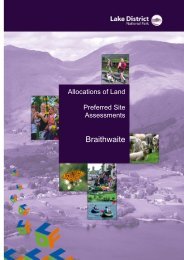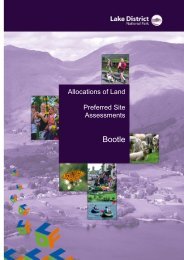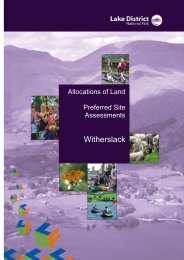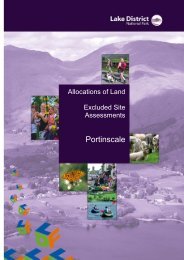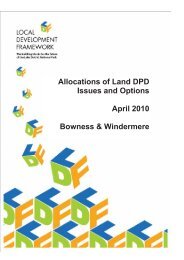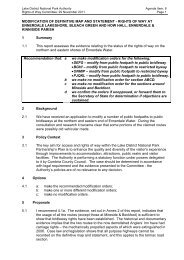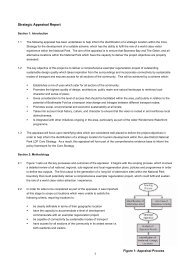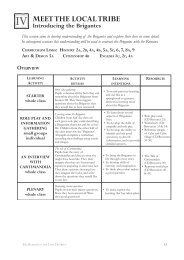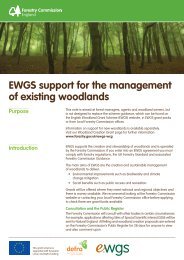The Partnership's Plan - Lake District National Park
The Partnership's Plan - Lake District National Park
The Partnership's Plan - Lake District National Park
You also want an ePaper? Increase the reach of your titles
YUMPU automatically turns print PDFs into web optimized ePapers that Google loves.
• <strong>The</strong>re are also challenges from loss in biodiversity and water quality; for example, in the<br />
number of species rich hay meadows and associated species such as breeding wading<br />
birds; as a result of production led farming. <strong>The</strong>re could also be a link between modernisation<br />
of farming practices and detraction of visitor experiences.<br />
• Farming businesses need to adapt to climate change, in particular flooding and more<br />
extreme weather patterns that are sustainable for the future.<br />
• Agriculture is characterised by an ageing workforce. Wages are low when compared to other<br />
industries. <strong>The</strong> problem is more acute in Less Favoured Areas and it is difficult to attract<br />
young people into the industry. A lack of housing availability and relatively low farm rents<br />
causing less incentive to leave, mean there is an intensification of barriers to new entrants.<br />
• About 11 per cent of the <strong>National</strong> <strong>Park</strong> is woodland, a combination of ancient, natural and<br />
plantations. Managed woodlands have been part of the Cumbrian landscape for over 200<br />
years and Grizedale and Whinlatter forests are some of our most popular tourist destinations.<br />
Traditional woodlands play an increasingly important role in sustaining livelihoods through<br />
coppicing, biofuel production and green woodworking. Forestry delivers multiple benefits<br />
from flood control, landscape enhancement as well as health, education and well being<br />
qualities. And much of the woodland in the <strong>National</strong> <strong>Park</strong> is an untapped economic resource.<br />
• In 2005, 178,532ha of the <strong>National</strong> <strong>Park</strong> were within Environmentally Sensitive Areas. <strong>The</strong><br />
key landscapes under agreement are:<br />
o Heather and ‘white’ fell 91,741ha<br />
o Woodland<br />
2,458ha<br />
o Meadowland<br />
765ha<br />
• <strong>The</strong>re are currently more large and small farms than medium-sized farms, as farms<br />
amalgamate and farmhouses are sold on, often to second homeowners. <strong>The</strong> challenging<br />
landscape of the <strong>Lake</strong> <strong>District</strong> makes farming labour-intensive.<br />
• An important part of farming is also the unique cultural heritage it has brought, and continues<br />
to bring, to the area including skills such as construction and repair of stone wall.<br />
3.1.2 Recent activity and successes<br />
Farming and forestry are major land uses across most of the area. Most public financial support is<br />
linked to environmental enhancement, delivered by farmers, foresters and land managers. At its<br />
peak, the <strong>Lake</strong> <strong>District</strong> Environmentally Sensitive Area, which started in 1993, covered 245,390 ha.<br />
Ten year management agreements, which end in 2013, have funded millions of pounds worth of<br />
projects including grazing reduction, commons management, restoration of farm buildings,<br />
hedgerows, stone walls and tree planting. <strong>The</strong> Environmental Stewardship Scheme replaced the<br />
ESA in 2005 and more than 42,718 ha are already in the scheme, with a further 103,064 ha in ESA<br />
(as of August 2010). <strong>The</strong>re is also Rural Development Programme for England funding, through<br />
Cumbria Fells and Dales Local Area Group.<br />
<strong>The</strong> Forestry Commission provides important data on the size, location and composition of<br />
woodlands that forms the foundation of much research. Statistical analysis and data management,<br />
surveying and computer modelling are crucial; they ensure our woodlands contribute effectively to<br />
climate change management, biodiversity, economic viability and social value.<br />
We will measure the percentage of the <strong>National</strong> <strong>Park</strong> which is being managed in line with <strong>National</strong><br />
<strong>Park</strong> objectives. This will show how well farmers and land managers are protecting and enhancing<br />
the special qualities of the <strong>National</strong> <strong>Park</strong>. It will also indicate the economic value of these schemes.<br />
This will help us understand the link with changes in land ownership, size of farms and availability of<br />
workers.<br />
26



